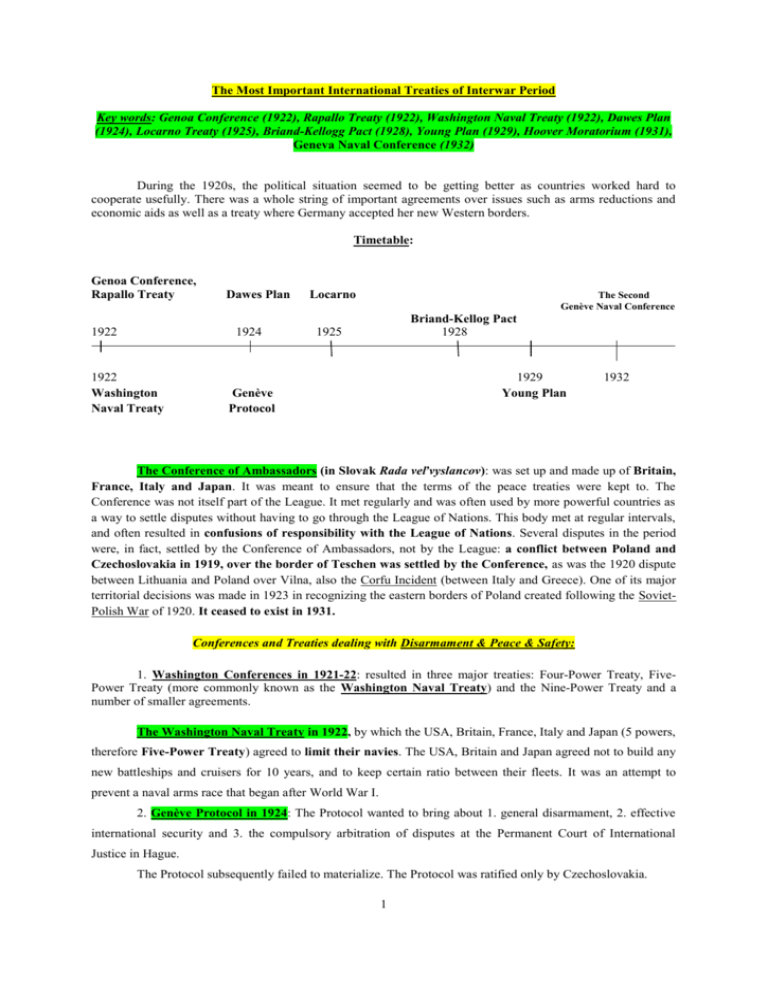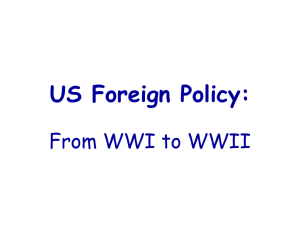Rapallo Treaty (1922)
advertisement

The Most Important International Treaties of Interwar Period Key words: Genoa Conference (1922), Rapallo Treaty (1922), Washington Naval Treaty (1922), Dawes Plan (1924), Locarno Treaty (1925), Briand-Kellogg Pact (1928), Young Plan (1929), Hoover Moratorium (1931), Geneva Naval Conference (1932) During the 1920s, the political situation seemed to be getting better as countries worked hard to cooperate usefully. There was a whole string of important agreements over issues such as arms reductions and economic aids as well as a treaty where Germany accepted her new Western borders. Timetable: Genoa Conference, Rapallo Treaty 1922 Dawes Plan 1924 1922 Washington Naval Treaty Locarno The Second Genève Naval Conference Briand-Kellog Pact 1928 1925 1929 Young Plan Genève Protocol 1932 The Conference of Ambassadors (in Slovak Rada veľvyslancov): was set up and made up of Britain, France, Italy and Japan. It was meant to ensure that the terms of the peace treaties were kept to. The Conference was not itself part of the League. It met regularly and was often used by more powerful countries as a way to settle disputes without having to go through the League of Nations. This body met at regular intervals, and often resulted in confusions of responsibility with the League of Nations. Several disputes in the period were, in fact, settled by the Conference of Ambassadors, not by the League: a conflict between Poland and Czechoslovakia in 1919, over the border of Teschen was settled by the Conference, as was the 1920 dispute between Lithuania and Poland over Vilna, also the Corfu Incident (between Italy and Greece). One of its major territorial decisions was made in 1923 in recognizing the eastern borders of Poland created following the SovietPolish War of 1920. It ceased to exist in 1931. Conferences and Treaties dealing with Disarmament & Peace & Safety: 1. Washington Conferences in 1921-22: resulted in three major treaties: Four-Power Treaty, FivePower Treaty (more commonly known as the Washington Naval Treaty) and the Nine-Power Treaty and a number of smaller agreements. The Washington Naval Treaty in 1922, by which the USA, Britain, France, Italy and Japan (5 powers, therefore Five-Power Treaty) agreed to limit their navies. The USA, Britain and Japan agreed not to build any new battleships and cruisers for 10 years, and to keep certain ratio between their fleets. It was an attempt to prevent a naval arms race that began after World War I. 2. Genève Protocol in 1924: The Protocol wanted to bring about 1. general disarmament, 2. effective international security and 3. the compulsory arbitration of disputes at the Permanent Court of International Justice in Hague. The Protocol subsequently failed to materialize. The Protocol was ratified only by Czechoslovakia. 1 3. Briand-Kellogg Pact in 1928 (after foreign ministers of France, Aristide Briand1 and the USA, Frank B. Kellogg): The Treaty was signed in Paris by 45 countries including Germany. All these countries agreed never to resort to war again. Later, the number of countries went up to 65. The pact renounced aggressive war, prohibiting the use of war as "an instrument of national policy" except in matters of self-defense. The problem with the Pact was that it did not provide any way to enforce its terms. This meant it could only work if countries kept their word. For example, in 1931 Japan with no problem ignored the agreement. The Pact was binding only for its signatories and stated no provisions for sanctions. Pact, Article 1: “The High Contracting Parties declare … that they condemn recourse (resorting) to war for the solution of international controversies (disputes) and renounce it (give it up) as an national policy in their relations with one other.” Pact Article 2: “The Parties agree that the settlement or solution of all disputes or conflicts of whatever nature which arise among them, shall never be sought except by pacific (peaceful) means.” The Pact also showed that world leaders still preferred to sign treaties and pacts rather than rely upon the League of Nations and the idea of collective security. However, the Pact did help to involve the USA again in international affairs. 4. The Second Genève Naval Conference in 1932: was a conference held to discuss naval arms limitation. Apart from naval disarmaments, a reduction in land forces and limits on weapons were also discussed at the conference. Conferences and Treaties dealing with Borders: 1. Locarno Treaty in 1925: Germany in this Treaty agreed to accept the demilitarization of Rhineland and its borders with France and Belgium. Although Germany did not promise to accept its eastern borders, it did agree that changes would be made by negotiation not war. This Treaty led Germany being allowed to join the League in 1926, and to an optimistic feeling about peace, known as a “spirit of Locarno”. The Treaty was signed between Germany, France, Belgium, the United Kingdom, and Italy. The first three signatories undertook not to attack each other, with the latter two acting as guarantors. In the event of aggression by any of the first three states against another, all other parties were to assist the country under attack. Germany also agreed to sign arbitration conventions with France and Belgium and arbitration treaties with Poland and Czechoslovakia, undertaking to refer disputes to an arbitration tribunal or to the Permanent Court of International Justice. France signed further treaties with Poland and Czechoslovakia, pledging mutual assistance in the event of unprovoked conflict led by Germany. These essentially reaffirmed existing treaties of alliance concluded by France with Poland in 1921 and with Czechoslovakia in 1924. Once France had abandoned its allies in Eastern Europe, thereby creating a situation where the Poles and Czechoslovaks having no Great Power to protect them from Germany, would be forced to adjust to German demands, and hence in the British viewpoint would peacefully hand over the territories claimed by Germany such as the Sudetenland, the Polish Corridor and the Free City of Danzig. In this way, promoting territorial revisionism in Eastern Europe in Germany’s favor was one of the principal British objects of Locarno, making Locarno an early instance of appeasement. In other words: 1. Germany, France and Belgium agreed that their borders were final, fixed. Britain and Italy guaranteed this. Western borders of Germany were set as final, France and Belgium felt save. 2. But Czechoslovakia and Poland did not feel save, because eastern borders of Germany were not guaranteed as 1 Aristide Briand is noted as among the first to propose a union of European nations. 2 fixed. Arbitration treaties could not correct the feeling that the Czechs and the Poles were betrayed by the western Allies. Locarno was a milestone for Czechoslovakia: from now on we had to bear in mind the idea that Germany might attack us one day and that we can not rely on the help of the Allies, 3. The Rhineland to remain demilitarized. Conferences and Treaties dealing with the Economy and Payments: 1. Genoa Conference 1922: (watch out: Genoa = Janov, Genève = Ženeva): At this conference, the representatives of 28 countries (not the USA and Turkey) convened to speak about monetary economy in the wake of World War I. The purpose was to formulate strategies to rebuild Europe after the war, and also to negotiate a relationship between European capitalist economies, and the new Russian Communist economy (Georgy Chicherin). The Conference also aimed for the integration of Russia and Germany into the continent, because their political and economical absence was considered as undesirable. The conference failed: 1. the West did not want to provide the Soviets with credits, 2. the West did not want to give the Soviets recognition de iure of their state. 3. On the other side, the Soviets did not want to accept tsarist debts. 2. Rapallo Treaty 1922: The Treaty of Rapallo was an agreement signed in the Italian town of Rapallo between Germany (the Weimar Republic) and Soviet Russia under which each renounced all territorial and financial claims against the other following the Treaty of Brest-Litovsk and World War I. The two governments also agreed to normalise their diplomatic relations and to "co-operate in a spirit of mutual goodwill in meeting the economic needs of both countries". Berlin recognized Soviets de iure and gave up its claims on the nationalized German possession. 3. Dawes Plan in 1924: the main points of The Dawes Plan were: 1. 2. 3. The Ruhr area was to be evacuated by Allied occupation troops (the Ruhr crisis - France and Belgium invaded the Ruhr after Germany failed to pay its second reparations installment) The payments were lowered and the period to pay off the reparations was prolonged. The Reichsbank would be reorganized under Allied supervision. The Dawes Plan relied on money given to Germany by Great Britain, but mainly by the US. The Dawes Plan provided short term economic benefits to the German economy. It softened the burdens of war reparations, stabilized the currency, and brought increased foreign investments and loans to the German market. However, it made the German economy dependent on foreign markets and economies, and therefore problems with the U.S. economy (e.g. the Great Depression) would later severely hurt Germany as it did the rest of the western world, which was subject to debt repayments for loans of American dollars. 4. Young Plan in 1929: The Young Plan was a program for settlement of German reparations debts after World War I written in 1929 and formally adopted in 1930. After the Dawes Plan was put into operation (1924), it became apparent that Germany could not meet the huge annual payments, especially over an indefinite period of time. The Young Plan reduced further payments to 112 billion Gold Marks, US $8 billion in 1929 (US$ 103 billion in 2010) over a period of 59 years (1988). The benefits of the Dawes and Young Plans were wiped out by the economic Depression which was soon to affect everybody. + Hoover´s moratorium 1931: The Hoover Moratorium was a public statement issued by U.S. President Herbert Hoover on June 20, 1931 in order to deal with a very serious banking collapse in Central 3 Europe that threatened to cause a worldwide financial melt-down. It called for a one-year halt in reparations payments by Germany to France and of Allied war debts to the United States. Work to do: Mark the purpose of each treaty or conference Treaties and Conferences The purpose of the treaty or conference Disarmament or Peace or Safety Payments Borders Washington Naval Treaty in 1922 Genoa Conference in 1922 Rapallo Treaty in 1922: The Genève Protocol in 1924: Dawes Plan in 1924 Locarno Treaty in 1925 Briand-Kellogg Pact in 1928 Young Plan in 1929 + Hoover´s moratorium in 1931 Geneva Naval Conference in 1932 4 Economy Your Notes








